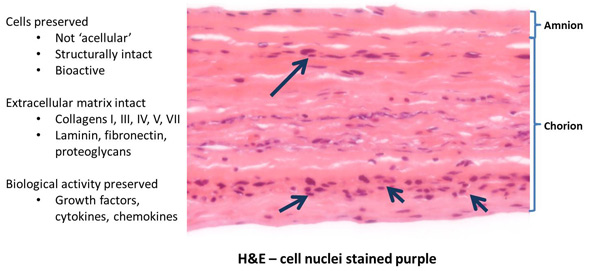|
Christopher K
Bromley, DPM
|
Human allografts have been used since the early 1900s. In the late 1990s, the use of human amnion / chorion grafts became popular in ocular surgery and have become more popular lately in wound healing due to their properties of being: immunologically-privileged, anti-inflammatory, and having growth factors, extracellular matrix and cellular signaling abilities.
Human amniotic membrane is comprised of the innermost layer of the placenta that lines the amniotic cavity. The membrane is composed of multiple layers, including a single layer of epithelial cells, a basement membrane and an avascular connective tissue matrix. The tissues of the placenta present a very complex interrelationship of materials that possess numerous physiologic characteristics that can, in turn, change in importance with the appropriate stage of gestation. During pregnancy, the placenta permits the passage of nutrients, metabolites and metabolic gases, and provides physical and immunological protection to the developing fetus. In addition, it produces a variety of steroids and important metabolic hormones.
Amniotic membrane is a unique material and its composition contains collagen types I, III, IV, V, and VII. Amniotic membrane is composed of structural extracellular matrix (ECM) that also contains specialized proteins, fibronectin, laminins, proteoglycans and glycosaminoglycans. In addition, amniotic membrane contains essential, healing growth factors such as epidermal growth factor (EGF), transforming growth factor beta (TGF-b), fibroblast growth factor (FGF), and platelet-derived growth factor (PDGF). Amniotic tissues have shown little to no HLA-A, B, C antigens and β2 microglobulin.

EpiFix® is a dehydrated Human Amnion/Chorion Membrane (dHACM) allograft and is composed of multiple layers including a single layer of epithelial cells, a basement membrane and an avascular connective tissue matrix. EpiFix®is a minimally manipulated, dehydrated, non-viable cellular amniotic membrane allograft that contains multiple extracellular matrix proteins, growth factors, cytokines, and other specialty proteins present in amniotic tissue to help regenerate soft tissue.
 EpiFix® Amnion/Chorion Membrane Allograft for Acute and Chronic Wound Care
EpiFix® Amnion/Chorion Membrane Allograft for Acute and Chronic Wound Care
- Enhances Healing
- Reduces Inflammation
- Reduces Scar Tissue Formation
EpiFix® is processed using the PURION® Process, a unique approach that provides an easy to use graft that may be stored at ambient conditions for up to five years. With a variety of sizes available, EpiFix® has size-appropriate grafts to minimize wastage.
Case Report
- 62 year-old male with a history of diabetes, neuropathy, peripheral arterial disease and prior amputations
- Nonsmoker
- Controlled A1c of 6.2
- Controlled HTN
- ABI 1.2 right LE and 1.4 left: calcifications noted in DP bilateral
- Grade II 2.0cm x 1.5cm x .3cm plantar ulcer plantar left foot below prior 5th met
- Partial resection fifth metatarsal head two years ago.
Prior Treatment
- Patient is managed by a multi-disciplinary approach: Primary care is managing multiple medical conditions; Endocrinology is managing diabetes; Vascular performed prior bypass of LE bilaterally; Podiatry managed prior amputations, regular diabetic foot care, off loading and diabetic shoe gear.
- Prior wound care included numerous modalities to address chronic ulceration below fifth MPJ including wide excision of ulcer after partial fifth ray amputation for osteomyelitis.
- Despite biopsy negative for malignacy, the ulceration fails to heal.
dHACM Treatment
Wound size appropriate dHACM allografts were applied weekly after debridement followed by standard dressings until complete epithelialization occurred.
Post EpiFix® application: 2 grafts applied week 1 and week 2: this picture is at week 4 |
|
|
Summary
Dehydrated human amnion/chorion allografts are an excellent tool in treating chronic diabetic foot wounds.


 MiMedx® delivers innovative bioactive healing products for tissue regeneration MiMedx® delivers innovative bioactive healing products for tissue regeneration
MiMedx® is the global premier processor, marketer, and distributor of human amniotic tissue. MiMedx® has distributed over 300,000 amniotic tissue grafts worldwide and achieved profound clinical outcomes in multiple therapeutic areas including ophthalmology, spine, chronic wounds, dental, orthopedic surgery, sports medicine, and urology. With this groundbreaking human tissue offering that promotes healing, MiMedx® believes its unmatched knowledge and superior processing of amniotic tissue strategically positions the Company to become the leader in regenerative medicine. |
|
For more information please contact us
at 888.543.1917 or use our contact form on our website. |
|